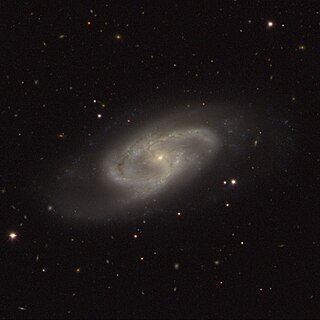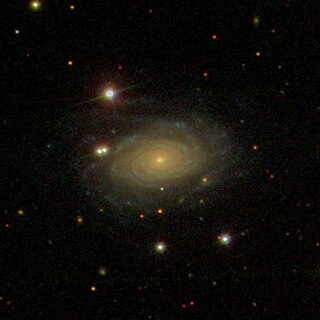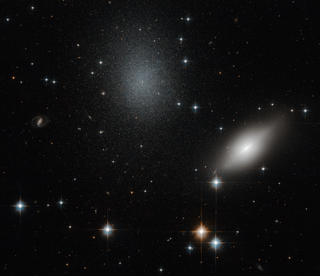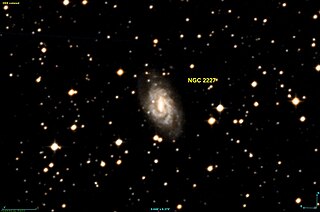
NGC 3258 is an elliptical galaxy in the constellation Antlia. It is a member of the Antlia Cluster, which lies about 40.7 megaparsecs away. It was discovered on May 2, 1834 by John Herschel.

NGC 6850 is a barred lenticular galaxy in the constellation Telescopium, discovered by John Herschel in 1836.

NGC 3718, also called Arp 214, is a galaxy located approximately 52 million light years from Earth in the constellation Ursa Major. It is either a lenticular or spiral galaxy.

NGC 150 is a barred spiral galaxy in the constellation Sculptor. It is about 70 million light years away from the Solar System, and it has a diameter of about 55,000 light years. It was discovered on 20 November 1886, by Lewis A. Swift. The Type II supernova SN 1990K was detected in NGC 150, and was reported to be similar to SN 1987A.

NGC 251 is a spiral galaxy in the constellation of Pisces. It was discovered on October 15, 1784, by Frederick William Herschel.

NGC 252 is a lenticular galaxy located in the constellation Andromeda. It was discovered by William Herschel in 1786.

NGC 5011 is an elliptical galaxy in the constellation of Centaurus. It was discovered on 3 June 1834 by John Herschel. It was described as "pretty bright, considerably small, round, among 4 stars" by John Louis Emil Dreyer, the compiler of the New General Catalogue.

NGC 1573 is an elliptical galaxy in the constellation of Camelopardalis. It was discovered on 1 August 1883 by Wilhelm Tempel. It was described as "very faint, small" by John Louis Emil Dreyer, the compiler of the New General Catalogue. It is located about 190 million light-years away.

NGC 5559 is a barred spiral galaxy, located 240 million light-years away in the constellation of Boötes. It was discovered on April 10, 1785, by the astronomer William Herschel.

NGC 3697 is a spiral galaxy in the constellation of Leo. It was discovered on 24 February 1827 by John Herschel. It was described as "extremely faint, very small, extended 90°" by John Louis Emil Dreyer, the compiler of the New General Catalogue. It is a member of HCG 53, a compact group of galaxies.

NGC 3402, also known as NGC 3411, is an elliptical galaxy in the constellation Hydra. The object was discovered on March 25, 1786 by German-British astronomer William Herschel. NGC 3402 is the largest galaxy in the eponymous NGC 3402 cluster.

NGC 2998 is a barred spiral galaxy located in the constellation Ursa Major. It is 195 million light-years away from the Earth. It is an intermediate spiral galaxy. Its stellar mass is about that of the Milky Way.

NGC 2227 is a barred spiral galaxy with a morphological type of SB(rs)c located in the direction of the Canis Major constellation. It was discovered on January 27, 1835, by John Herschel.

NGC 996 is an elliptical galaxy of the Hubble type E0 in the constellation Andromeda. It is estimated to be 210 million light years from the Milky Way and has a diameter of approximately 75,000 ly. The supernova SN 1996bq occurred in this galaxy. NGC 996 was discovered on December 7, 1871 by astronomer Édouard Stephan.

NGC 531 is a barred spiral galaxy in the constellation Andromeda with a visual magnitude of 10.51. It is a distance of 65.7 Mpc from the Sun. It is a member of the Hickson Compact Group HCG 10, and is interacting with the other members of the group.

NGC 941 is an intermediate spiral galaxy in the constellation Cetus. It is an estimated 16.83 MPc from the Milky Way and has a diameter of approximately 55,000 light years. The galaxies NGC 926, NGC 934, NGC 936, NGC 955 are located in the same sky area. NGC 941 was discovered by the astronomer William Herschel on 6 January 1785.

NGC 644 is a barred spiral galaxy in the constellation Phoenix in the southern sky. It is estimated to be 270 million light-years from the Milky Way and has a diameter of approximately 130,000 light-years. Together with NGC 641, it probably forms a gravitationally bound pair of galaxies. The object was discovered on September 5, 1834 by John Herschel.

NGC 3073 is a dwarf lenticular galaxy in the constellation Ursa Major. It is at a distance of about 65 million light-years from Earth. NGC 3073 was discovered by astronomer William Herschel on April 1, 1790. The galaxy belongs to the NGC 3079 Group.

NGC 3613 is an elliptical galaxy in the constellation Ursa Major. It was discovered by the astronomer William Herschel on April 8, 1793. NGC 3613 is the center of a cluster of galaxies, and has an estimated globular cluster population of over 2,000.

NGC 3254 is a spiral galaxy in the constellation Leo Minor. It was discovered on March 13, 1785, by the astronomer William Herschel. It is a member of the NGC 3254 Group of galaxies, which is a member of the Leo II Groups, a series of galaxies and galaxy clusters strung out from the right edge of the Virgo Supercluster.




















